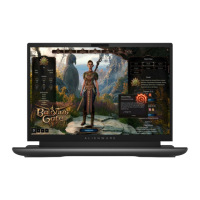CAUTION: Exercise caution when handling Lithium-ion batteries in laptops. Swollen batteries should not be used and
should be replaced and disposed properly.
NOTE: The color of your computer and certain components may appear differently than shown in this document.
Electrostatic discharge—ESD protection
ESD is a major concern when you handle electronic components, especially sensitive components such as expansion cards, processors,
memory DIMMs, and system boards. Very slight charges can damage circuits in ways that may not be obvious, such as intermittent
problems or a shortened product life span. As the industry pushes for lower power requirements and increased density, ESD
protection is an increasing concern.
Due to the increased density of semiconductors used in recent Dell products, the sensitivity to static damage is now higher than in
previous Dell products. For this reason, some previously approved methods of handling parts are no longer applicable.
Two recognized types of ESD damage are catastrophic and intermittent failures.
● Catastrophic – Catastrophic failures represent approximately 20 percent of ESD-related failures. The damage causes an
immediate and complete loss of device functionality. An example of catastrophic failure is a memory DIMM that has received a
static shock and immediately generates a "No POST/No Video" symptom with a beep code emitted for missing or nonfunctional
memory.
● Intermittent – Intermittent failures represent approximately 80 percent of ESD-related failures. The high rate of intermittent
failures means that most of the time when damage occurs, it is not immediately recognizable. The DIMM receives a static shock,
but the tracing is merely weakened and does not immediately produce outward symptoms related to the damage. The weakened
trace may take weeks or months to melt, and in the meantime may cause degradation of memory integrity, intermittent memory
errors, etc.
The more difficult type of damage to recognize and troubleshoot is the intermittent (also called latent or "walking wounded") failure.
Perform the following steps to prevent ESD damage:
● Use a wired ESD wrist strap that is properly grounded. The use of wireless anti-static straps is no longer allowed; they do not
provide adequate protection. Touching the chassis before handling parts does not ensure adequate ESD protection on parts with
increased sensitivity to ESD damage.
● Handle all static-sensitive components in a static-safe area. If possible, use anti-static floor pads and workbench pads.
● When unpacking a static-sensitive component from its shipping carton, do not remove the component from the anti-static
packing material until you are ready to install the component. Before unwrapping the anti-static packaging, ensure that you
discharge static electricity from your body.
● Before transporting a static-sensitive component, place it in an anti-static container or packaging.
ESD field service kit
The unmonitored Field Service kit is the most commonly used service kit. Each Field Service kit includes three main components:
anti-static mat, wrist strap, and bonding wire.
Components of an ESD field service kit
The components of an ESD field service kit are:
● Anti-Static Mat – The anti-static mat is dissipative and parts can be placed on it during service procedures. When using an
anti-static mat, your wrist strap should be snug and the bonding wire should be connected to the mat and to any bare metal on
the system being worked on. Once deployed properly, service parts can be removed from the ESD bag and placed directly on
the mat. ESD-sensitive items are safe in your hand, on the ESD mat, in the system, or inside a bag.
● Wrist Strap and Bonding Wire – The wrist strap and bonding wire can be either directly connected between your wrist and
bare metal on the hardware if the ESD mat is not required, or connected to the anti-static mat to protect hardware that is
temporarily placed on the mat. The physical connection of the wrist strap and bonding wire between your skin, the ESD mat,
and the hardware is known as bonding. Use only Field Service kits with a wrist strap, mat, and bonding wire. Never use wireless
wrist straps. Always be aware that the internal wires of a wrist strap are prone to damage from normal wear and tear, and must be
checked regularly with a wrist strap tester in order to avoid accidental ESD hardware damage. It is recommended to test the wrist
strap and bonding wire at least once per week.
● ESD Wrist Strap Tester – The wires inside of an ESD strap are prone to damage over time. When using an unmonitored kit, it is a
best practice to regularly test the strap prior to each service call, and at a minimum, test once per week. A wrist strap tester is the
7

